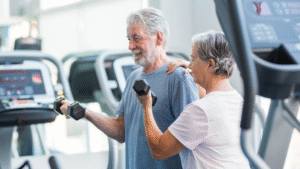High-Intensity Interval Training (HIIT) and Zone 2 cardio are two popular training styles, but which is best for living longer? The answer: they both have merits. HIIT (short bursts of near-max effort followed by rest) is great for quickly boosting fitness, while Zone 2 (sustained moderate pace, about 60–70% of max heart rate) builds endurance and metabolism. Let’s break down what science says about each, especially in terms of health and longevity.
What Is HIIT?
HIIT involves pushing your cardiovascular system hard in short intervals. For example, sprinting for 30 seconds, then resting or jogging for a minute, repeated for 15–20 minutes. HIIT workouts improve VO₂ max (maximal oxygen uptake) faster than steady exercise, and they can burn a lot of calories in a short time. Research shows HIIT can significantly improve blood pressure, cholesterol, and insulin sensitivity – sometimes even more quickly than moderate workouts.
However, HIIT is demanding. Harvard Health cautions that while younger, healthy people may thrive on HIIT, older adults or those with heart issues should be careful. Even one large study of healthy 70-year-olds found that while HIIT was safe under supervision, the long-term longevity benefit was similar whether people did HIIT or just moderate-intensity exercise. In short, HIIT is efficient for fitness but not strictly required for living longer.
What Is Zone 2 Cardio?
Zone 2 cardio means keeping your heart rate in a moderate zone – roughly 60–70% of your max heart rate (for many people, a pace where you can talk but not sing). This level of effort is sustainable for longer durations (30–90 minutes). Zone 2 has become trendy for its accessibility: even beginners, older adults, or those with health conditions can often do Zone 2 workouts safely.
Physiologically, Zone 2 training primarily uses fat for fuel, which can help with weight management and metabolic health. Mayo Clinic notes that during Zone 2 exercise your body “primarily uses fat as its fuel source,” resulting in increased fat burning and overall cardio fitness. Zone 2 also strengthens the heart muscle and improves mitochondrial function, contributing to better endurance and baseline health.
Comparing the Longevity Benefits
Which is better for living longer? Both can extend your lifespan, but in slightly different ways. The Harvard study mentioned above (in people in their 70s) found that those doing a few HIIT sessions per week did get fitness gains, but their reduction in mortality risk was not significantly greater than peers doing moderate exercise. In other words, **moderate-intensity workouts (like consistent Zone 2 training) were “just as good” for longevity as adding HIIT.
This aligns with broader research: studies often show that the total volume of exercise (and consistency) matters more than intensity alone for lifespan. However, combining the two types can be ideal. Zone 2 sessions build an aerobic base and burn fat efficiently, while a weekly HIIT session or two can boost your cardiovascular capacity and metabolism. Using a mixture keeps workouts interesting and covers all bases.
Practical Takeaways
Beginners & Overweight Adults: Start with Zone 2. It’s safer and more sustainable. You’ll build endurance and overall health without overtaxing your body. Simple brisk walking, jogging, swimming, or cycling at a steady pace counts as Zone 2.
Busy Schedules: If you’re short on time but already reasonably fit, adding a 15–20 minute HIIT once or twice a week can yield great benefits for VO₂ max and insulin sensitivity. Just ensure proper warm-up and listen to your body.
For Longevity: Mix it up. A typical approach: 2–3 Zone 2 cardio sessions (30–60 minutes each) plus 1–2 HIIT workouts per week. This balanced routine aligns with evidence that moderate cardio provides a significant longevity boost while occasional HIIT adds extra fitness gains.
Consistency Over Perfection: Ultimately, the best workout is the one you can stick with. Whether you prefer long slow runs, bike rides, or intense intervals, keep moving regularly. Over months and years, both moderate and interval training contribute to a healthier, longer life.












